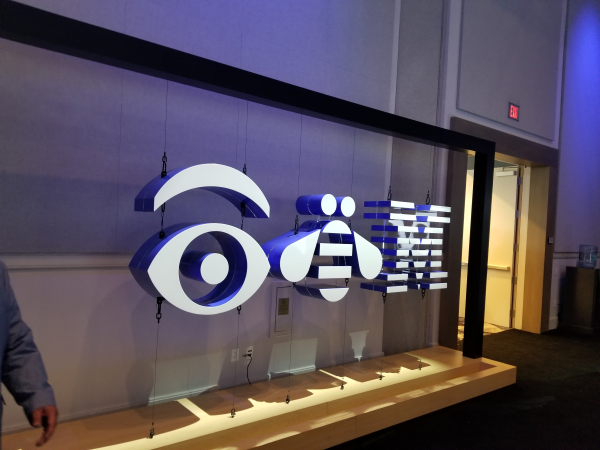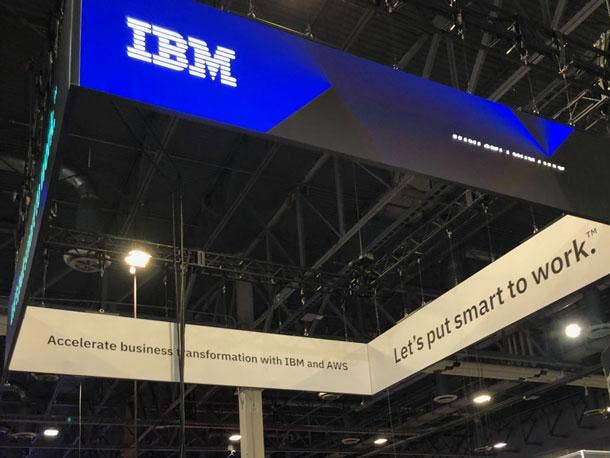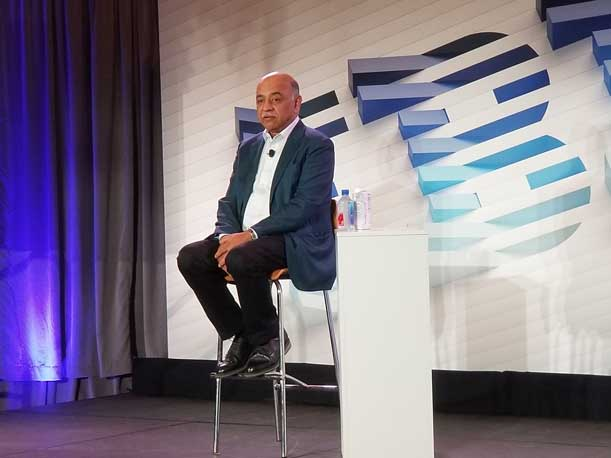IBM CEO Krishna To Partners: Let’s ‘Make Lots Of Money Together On AI’
GenAI “is going to generate business value for our clients,” IBM CEO Arvind Krishna told CRN.

This year, IBM solution providers will work to build customer trust in artificial intelligence (AI) and scale early use cases, CEO Arvind Krishna predicted in an interview with CRN for its February 2024 magazine issue.
“This is a super exciting time in the industry. We’ve got a big new wave coming in of generative AI,” Krishna told CRN. “It is going to generate business value for our clients. That is what gives them the confidence to scale it.”
Krishna also weighed in on some of the early use cases winning customers over, including code generation and augmenting human labor.
Krishna also discussed IBM’s evolving strategy around AI, including an explanation on mistakes made between Watson capturing the world’s attention by winning at chess and on the TV game show “Jeopardy,” and ChatGPT ushering in the current AI hype cycle.
“The mistake we made was to produce monolithic answers leveraging AI,” Krishna said. “Then we kind of said, whether we work with you or do the training on our own, it doesn’t matter. But let me give you a complete solution. And we have thought about it more than you can, so accept the solution. Whenever there’s a new technology, people want to tinker with it. They want to play with it. They want to experiment with it. And when you give them a black box complete answer, you can’t do that. That was the mistake that we made.”
Along with advancements in AI technology, IBM has corrected its AI mistakes through offerings such as the IBM Watson Studio that allow for tinkering and allowing for customers to bring their own models.
“That is why we are seeing the success that we have been for the last few months, which I’m certainly hoping with [partners] … we can redouble that yet again in ’24,” he said.
Krishna said IBM will not make the same mistake with another emerging technology that’s received heavy investment from the Armonk, N.Y.-based vendor – quantum computing.
IBM has a Qiskit developer toolkit available for users to experiment with quantum machines and run circuits.
“This time around, we have learned,” he said. “And we kind of went back to our roots. … The reason that a lot of people got to know IBM is because they got free classes in programming from IBM sales and branch offices 30, 40, 50 years ago on how to use mainframes. We kind of maybe lost that a little, but we are back to those same roots to say, ‘This is how you use the technology. This is how you get a massive advantage. Let us teach you how to do it.’ And our reward will come in the end when you prefer to buy our technology compared to other alternatives.”
Read on for more of what Krishna had to say to CRN.

What can we expect from IBM in 2024?
This is a super exciting time in the industry. We’ve got a big new wave coming in of generative AI. I know it can look like 2023 was the year of [AI]—there was really a lot of action, a lot of getting used to it.
In terms of deployment, especially what our partners have to do, ’24 and probably ’25 will be the years in which they’ll make the footprint [and] the clients will learn to trust them. They’ll begin to scale the use cases. … And it is going to generate business value for our clients. That is what gives them the confidence to scale it.
By the way, I will tell you that cloud and hybrid cloud are still ongoing. They’re far from done and mature.

How should IBM solution providers talk to customers about IBM AI?
We should really look upon the mixture of LLMs [large language models] and generative AI as new. … The general concept of AI we could debate, is it 10 years old, is it 20 years old, all the way from Watson beating [contestant and now host] Ken Jennings at ‘Jeopardy’ [in 2011], or Deep Blue beating Garry Kasparov at chess [in 1997]? Those are real AI examples. … We really want to help our enterprise customers on three major use cases.
Use case No. 1 is all around—I use the [term] ‘customer service,’ but you can think of contact centers, call centers, improving the experience of the end customer of our enterprise customer.
And there’s a lot of work to be done there—it’s not always replacing people. A lot of the time, it’s about making those people more productive and able to actually be better at customer service. And I think there’s a huge amount of work to be done there.
The second example is all around coding. Can we make somebody much better at deploying IT? Can we help somebody with the code inside [the organization]? And in both these cases, in many industries, people are not going to turn this information over to somebody else. They are going to worry about regulations, privacy, who’s learning from all of that data? So there is a place for all of this to be done in a hybrid environment.
And a third use case, which is going to grow over time, is digital labor. … Skilled people are very hard to get, so can I use digital labor to augment human labor? It’s not ‘replace,’ it is ‘augment’ so we can scale the company faster. We can get to new distribution channels, we can get to new ways of people and customers consuming the products or services of a company. … I kind of jokingly tell our team we don’t want to do a large language model to teach me to write an email in the voice of John Steinbeck.
It is great for some people. It’s a lot of fun. But that’s not us. Now, can we help you better tell somebody, maybe, which wealth management product is better for them based on the offerings from a particular bank, based on … which segment of the population and where? Maybe that’s more us.

Does IBM win enough with newer, startup customers and attract younger solution provider businesses?
We win a lot. I’ll give you some statistics and some examples. And I would then say, ‘But we should do even better.’ And that’s kind of why we’re here and we’re talking to our partners, who I think will be the route into those. … Amazon is a customer for us in software … hardware, too.
Uber is a customer. PayPal is a customer. These are really household names, brand names, but much younger companies. So certainly we get our share of companies like this. Now, having said that, I think we should have tens of thousands of such examples. … It comes down to, in the end, the innovation behind the products—Maximo, or we can mention Watsonx, or we can mention Apptio. I think these are all great products that apply to new and mature customers, both.

With the quick adoption of GenAI, has this changed your timeline for the adoption of quantum?
It’s a different technology. I know people love to combine them. And there is, I’ll say, an intersection where quantum would help AI. … I think the first set of problems that quantum will address are actually distinct from AI.
It is going to address problems in the materials world. Can I make a better alloy? Can I make a better lubricant to do something? Can I possibly make a better carbon fiber? How about EV batteries? This is, I think, a collection of really important problems that can be solved [with quantum]. We are doing some work with the Cleveland Clinic to understand not the shape of proteins, but actually how the shape of proteins may evolve during an illness because that could then give a possible answer on a therapeutic or preventive [solution]. ...
Maybe [quantum in risk] can help a bank give a better mortgage rate. OK, that’s pretty appealing to a consumer. Or if you can do a better assessment of what may happen, maybe the insurance company could reduce rates or improve their client segmentation. So risk has meaning back to us as consumers also. [The concept of] quantum supremacy [when quantum computers perform tasks that are impossible or impractical for conventional computers]—it’s kind of like artificial general intelligence. AI is very useful. We don’t need to get all the way to general intelligence.

You mentioned at the Think 2023 conference that IBM made a mistake in its approach to AI in the past. Have you learned from that mistake?
The mistake we made was to produce monolithic answers leveraging AI. Then we kind of said, whether we work with you or do the training on our own, it doesn’t matter. But let me give you a complete solution. And we have thought about it more than you can, so accept the solution.
Even in hindsight, the mistakes aren’t so obvious. Whenever there’s a new technology, people want to tinker with it. They want to play with it. They want to experiment with it. And when you give them a black box complete answer, you can’t do that. That was the mistake that we made.
So now, I will also tell you that maybe there was a reality to that mistake. At that time, all of AI was based on what we call ‘deep learning.’ That means you need to have lots of people to label the data, train it. And these models were arcane and required a room full of Ph.D.s in computer science to go get that done.
That’s hard to say, ‘You can go tinker with that,’ because our average client is not going to have that capacity of people to label and train and all of the rooms full of computer scientists.
Now with large language models, that onus or barrier has come way down. So now you can tinker and play. … That’s why this time around, we didn’t even begin with any ‘solutions’ or monolithic answers.
We began with, here’s a studio. Here’s how you refine a model. Oh, by the way, you can take in open-source models, not just ours. You can fine-tune that model. Hey, we can help you monitor the model. We can help you deploy the model.
So I think it’s a very different approach. And I think that is why we are seeing the success that we have been for the last few months, which I’m certainly hoping with [partners] … we can redouble that yet again in ’24.

Can we trust that the mistakes IBM made with AI will help IBM avoid the equivalent mistakes in quantum?
Absolutely. … We actually began with a developer toolkit called Qiskit. … We actually went with a free model. We have put … [IBM’s entire quantum computer fleet] on our cloud [and it is powered by utility-scale quantum processors with more than 100 qubits]. Actually, they’re free. Anybody can go access them and use them.
Now, look, you have got to wait. If there are lots of people using it, you have got to wait your turn. But that is in order to create a community of people who are doing their own experiments.
And they can do experiments to characterize a quantum machine. They can do and run what you would call higher-level ‘programs.’ … The quantum researchers will tell me, ‘No, no, no, we run circuits, not programs.’ Same difference for, I’ll say, laypeople. It’s all to solve a kind of problem.
So I think that this time around, we have learned. And we kind of went back to our roots. … The reason that a lot of people got to know IBM is because they got free classes in programming from IBM sales and branch offices 30, 40, 50 years ago on how to use mainframes.
We kind of maybe lost that a little, but we are back to those same roots to say, ‘This is how you use the technology. This is how you get a massive advantage. Let us teach you how to do it.’
And our reward will come in the end when you prefer to buy our technology compared to other alternatives. So I think we are there on quantum all the way.
Any other message to current and prospective IBM partners?
I’ll make a request … Let’s work together and make lots of money together on AI as all our clients want to go adopt this. The adoption is going to go from 20 percent to 90 percent. That’s a big wave to ride.